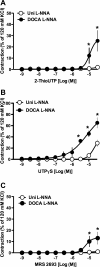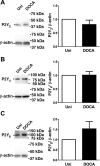Uridine adenosine tetraphosphate-induced contraction is increased in renal but not pulmonary arteries from DOCA-salt hypertensive rats
- PMID: 21551273
- PMCID: PMC3154666
- DOI: 10.1152/ajpheart.00084.2011
Uridine adenosine tetraphosphate-induced contraction is increased in renal but not pulmonary arteries from DOCA-salt hypertensive rats
Abstract
Uridine adenosine tetraphosphate (Up(4)A) was reported as a novel endothelium-derived contracting factor. Up(4)A contains both purine and pyrimidine moieties, which activate purinergic (P2)X and P2Y receptors. However, alterations in the vasoconstrictor responses to Up(4)A in hypertensive states remain unclear. The present study examined the effects of Up(4)A on contraction of isolated renal arteries (RA) and pulmonary arteries (PA) from DOCA-salt rats using isometric tension recording. RA from DOCA-salt rats exhibited increased contraction to Up(4)A versus arteries from control uninephrectomized rats in the absence and presence of N(G)-nitro-l-arginine (nitric oxide synthase inhibitor). On the other hand, the Up(4)A-induced contraction in PA was similar between the two groups. Up(4)A-induced contraction was inhibited by suramin (nonselective P2 antagonist) but not by diinosine pentaphosphate pentasodium salt hydrate (Ip(5)I; P2X(1) antagonist) in RA from both groups. Furthermore, 2-thiouridine 5'-triphosphate tetrasodium salt (2-ThioUTP; P2Y(2) agonist)-, uridine-5'-(γ-thio)-triphosphate trisodium salt (UTPγS; P2Y(2)/P2Y(4) agonist)-, and 5-iodouridine-5'-O-diphosphate trisodium salt (MRS 2693; P2Y(6) agonist)-induced contractions were all increased in RA from DOCA-salt rats. Protein expression of P2Y(2)-, P2Y(4)-, and P2Y(6) receptors in RA was similar between the two groups. In DOCA-salt RA, the enhanced Up(4)A-induced contraction was reduced by PD98059, an ERK pathway inhibitor, and Up(4)A-stimulated ERK activation was increased. These data are the first to indicate that Up(4)A-induced contraction is enhanced in RA from DOCA-salt rats. Enhanced P2Y receptor signaling and activation of the ERK pathway together represent a likely mechanism mediating the enhanced Up(4)A-induced contraction. Up(4)A might be of relevance in the pathophysiology of vascular tone regulation and renal dysfunction in arterial hypertension.
Figures






Similar articles
-
Uridine adenosine tetraphosphate and purinergic signaling in cardiovascular system: An update.Pharmacol Res. 2019 Mar;141:32-45. doi: 10.1016/j.phrs.2018.12.009. Epub 2018 Dec 13. Pharmacol Res. 2019. PMID: 30553823 Free PMC article. Review.
-
Alterations in vasoconstrictor responses to the endothelium-derived contracting factor uridine adenosine tetraphosphate are region specific in DOCA-salt hypertensive rats.Pharmacol Res. 2012 Jan;65(1):81-90. doi: 10.1016/j.phrs.2011.09.005. Epub 2011 Sep 14. Pharmacol Res. 2012. PMID: 21933714 Free PMC article.
-
Differential effects of uridine adenosine tetraphosphate on purinoceptors in the rat isolated perfused kidney.Br J Pharmacol. 2010 Oct;161(3):530-40. doi: 10.1111/j.1476-5381.2010.00914.x. Br J Pharmacol. 2010. PMID: 20880394 Free PMC article.
-
Enhanced uridine adenosine tetraphosphate-induced contraction in renal artery from type 2 diabetic Goto-Kakizaki rats due to activated cyclooxygenase/thromboxane receptor axis.Pflugers Arch. 2014 Feb;466(2):331-42. doi: 10.1007/s00424-013-1330-0. Epub 2013 Jul 31. Pflugers Arch. 2014. PMID: 23900807
-
G protein-coupled purinergic P2Y receptors in infectious diseases.Pharmacol Ther. 2025 Mar;267:108796. doi: 10.1016/j.pharmthera.2025.108796. Epub 2025 Jan 13. Pharmacol Ther. 2025. PMID: 39814144 Review.
Cited by
-
Amplification of the COX/TXS/TP receptor pathway enhances uridine diphosphate-induced contraction by advanced glycation end products in rat carotid arteries.Pflugers Arch. 2019 Dec;471(11-12):1505-1517. doi: 10.1007/s00424-019-02330-y. Epub 2019 Nov 18. Pflugers Arch. 2019. PMID: 31736003
-
Uridine adenosine tetraphosphate and purinergic signaling in cardiovascular system: An update.Pharmacol Res. 2019 Mar;141:32-45. doi: 10.1016/j.phrs.2018.12.009. Epub 2018 Dec 13. Pharmacol Res. 2019. PMID: 30553823 Free PMC article. Review.
-
The role of uridine adenosine tetraphosphate in the vascular system.Adv Pharmacol Sci. 2011;2011:435132. doi: 10.1155/2011/435132. Epub 2011 Nov 1. Adv Pharmacol Sci. 2011. PMID: 22110488 Free PMC article.
-
Uridine Adenosine Tetraphosphate-Induced Coronary Relaxation Is Blunted in Swine With Pressure Overload: A Role for Vasoconstrictor Prostanoids.Front Pharmacol. 2018 Mar 26;9:255. doi: 10.3389/fphar.2018.00255. eCollection 2018. Front Pharmacol. 2018. PMID: 29632487 Free PMC article.
-
Uridine adenosine tetraphosphate is a novel neurogenic P2Y1 receptor activator in the gut.Proc Natl Acad Sci U S A. 2014 Nov 4;111(44):15821-6. doi: 10.1073/pnas.1409078111. Epub 2014 Oct 23. Proc Natl Acad Sci U S A. 2014. PMID: 25341729 Free PMC article.
References
-
- Abbracchio MP, Burnstock G, Boeynaems JM, Barnard EA, Boyer JL, Kennedy C, Knight GE, Fumagalli M, Gachet C, Jacobson KA, Weisman GA. International union of pharmacology LVIII: update on the P2Y G protein-coupled nucleotide receptors: from molecular mechanisms and pathophysiology to therapy. Pharmacol Rev 58: 281–341, 2006 - PMC - PubMed
-
- Bar I, Guns PJ, Metallo J, Cammarata D, Wilkin F, Boeynams JM, Bult H, Robaye B. Knockout mice reveal a role for P2Y6 receptor in macrophages, endothelial cells, and vascular smooth muscle cells. Mol Pharmacol 74: 777–784, 2008 - PubMed
-
- Barnes PJ, Liu SF. Regulation of pulmonary vascular tone. Pharmacol Rev 47: 87–131, 1995 - PubMed
-
- Benter IF, Canatan H, Benboubetra M, Yousif MH, Akhtar S. Global upregulation of gene expression associated with renal dysfunction in DOCA-salt-induced hypertensive rats occurs via signaling cascades involving epidermal growth factor receptor: a microarray analysis. Vascul Pharmacol 51: 101–109, 2009 - PubMed
Publication types
MeSH terms
Substances
Grants and funding
LinkOut - more resources
Full Text Sources
Medical
Miscellaneous

